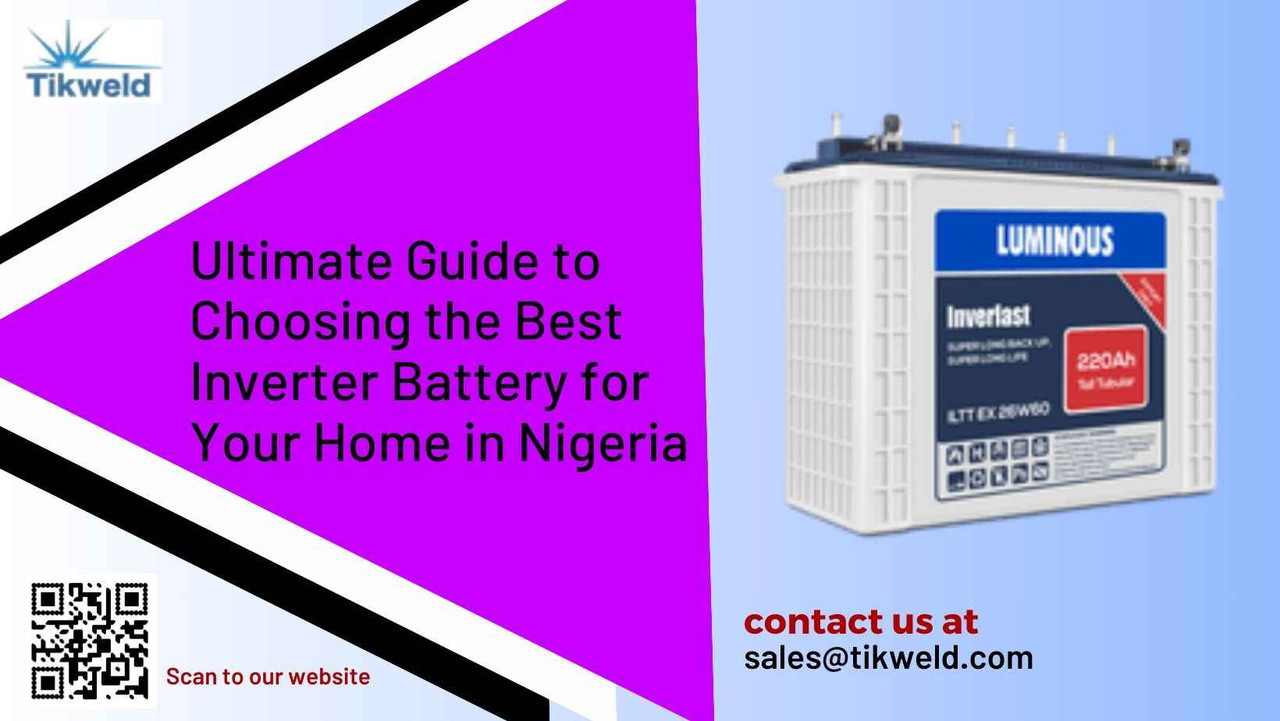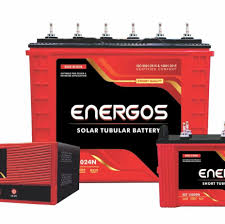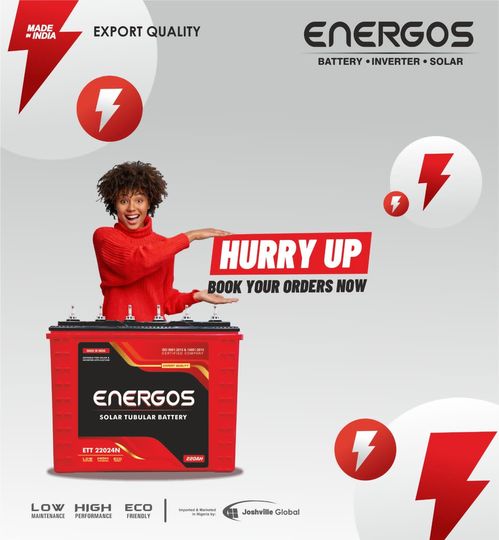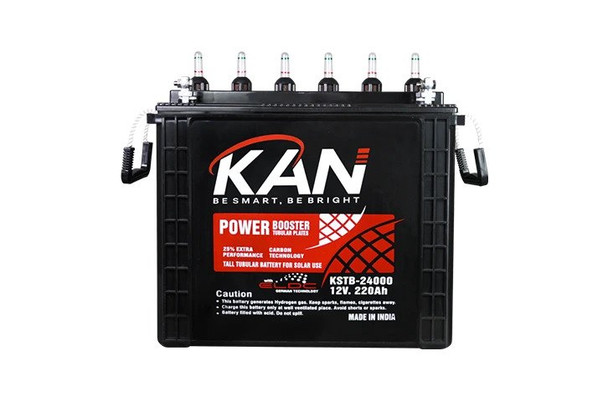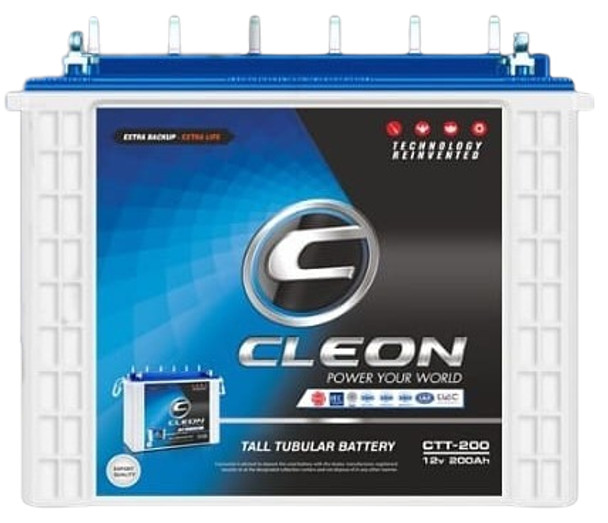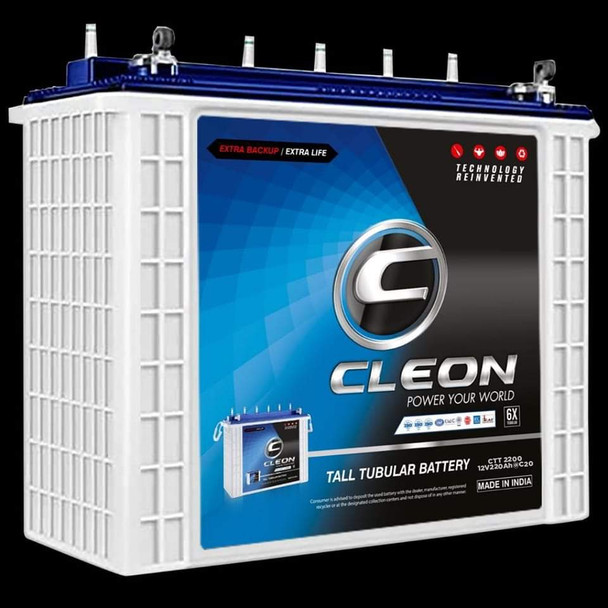Ultimate Guide to Choosing the Best Inverter Battery for Your Home in Nigeria
The significance of an inverter battery cannot be overstated when it comes to maintaining uninterrupted power backup. Whether for homes, small businesses, or large organizations such as hospitals and data centers, a reliable inverter battery ensures seamless operations during electricity outages. Investing in a high-quality inverter battery not only allows you to carry on with daily activities without disruption but also proves to be a cost-effective and eco-friendly choice, reducing the reliance on fossil fuel-based generators and contributing to a sustainable energy solution.
As the demand for reliable power sources continues to rise in Nigeria, the role of inverters in providing uninterrupted electricity has become increasingly crucial. A key component of any inverter system is the battery, and selecting the right one is paramount to ensuring optimal performance and long-term sustainability. In navigating the vast array of inverter batteries available in the market, it's essential to arm yourself with insightful tips that can streamline the decision-making process. Some of the best brands to choose from include Kan, Lento, Cleon and Lemax brand of inverter batteries.
When it comes to choosing the best inverter battery, understanding your power consumption patterns is crucial; this knowledge will help you determine the appropriate battery capacity to meet your household's needs. Additionally, consider the battery type, as options like tubular, flat plate, and gel batteries each come with their own set of advantages and disadvantages. Climate plays a role too, as the Nigerian climate can impact battery performance. Look for batteries designed to withstand high temperatures commonly experienced in the country. Further, checking the brand reputation, warranty, and user reviews provides valuable insights into the reliability and longevity of the chosen battery.
By heeding these tips, you'll be well-equipped to choose an inverter battery that not only aligns with your immediate power requirements but also proves to be a durable and cost-effective investment for the long run.
Understanding Your Power Needs
Before you choose an inverter battery for your home, you need to understand your power needs and how they affect your battery performance. The following steps will help you to assess your power consumption patterns, determine your load requirements, and calculate your battery capacity.
Assessing Power Consumption Patterns
Your power consumption patterns refer to how much and how often you use electricity in your home. This depends on the number and type of appliances you have, how frequently you use them, and for how long. For example, if you have a refrigerator, a freezer, an air conditioner, and a washing machine, and you use them every day for several hours, your power consumption will be high. On the other hand, if you only have a few lights, a fan, a TV, and a laptop, and you use them sparingly, your power consumption will be low.
To assess your power consumption patterns, you can use a power meter or a smart plug to measure the energy usage of each appliance. Alternatively, you can check the power rating label or the user manual of each appliance to find out its wattage. The wattage is the amount of power an appliance consumes per hour. For example, a 50-inch TV may have a wattage of 150W, which means it consumes 150 watts of power every hour.
Determining Load Requirements
Your load requirements refer to the total amount of power you need to run all the appliances you want to use on your inverter. To determine your load requirements, you need to add up the wattage of all the appliances you plan to run on the inverter. For example, if you want to use a laptop, a standing fan, a DSTV, a 50-inch TV, and 10 energy-efficient bulbs on your inverter, your load requirements will be:
Laptop: 60W Standing Fan: 50W DSTV: 20W 50-inch TV: 150W 10x 9 watt Energy Efficient Bulbs: 90W TOTAL: 370W
It is recommended to choose an inverter with at least double the capacity of your load requirements. This provides extra capacity and reduces the risk of overloading. For a load requirement of 370W, an inverter size of 800W or above would be suitable.
Calculating Battery Capacity
Your battery capacity refers to the amount of energy your battery can store and deliver to your inverter. The battery capacity is measured in ampere-hours (Ah), which is the product of the current (in amperes) and the time (in hours) that the battery can supply. For example, a 12V battery with a capacity of 200Ah can supply 12 volts of current for 200 hours.
To calculate your battery capacity, you need to know your backup time and your power factor. Your backup time is the duration of time you want your inverter to provide power when there is no grid power. Your power factor is the ratio of the actual power (in watts) to the apparent power (in volt-amperes) that your inverter delivers. The power factor ranges from 0 to 1, and it depends on the efficiency and quality of your inverter. A higher power factor means a more efficient inverter.
The formula for calculating your battery capacity is:
Battery Capacity (Ah) = (Load Requirement (W) x Backup Time (h)) / (Battery Voltage (V) x Power Factor)
For example, if you have a load requirement of 370W, a backup time of 5 hours, a battery voltage of 12V, and a power factor of 0.8, your battery capacity will be:
Battery Capacity (Ah) = (370W x 5h) / (12V x 0.8) = 193.75Ah
You can round up your battery capacity to the nearest standard size available in the market. For example, you can choose a 12V/200Ah battery for your inverter.
Types of Inverter Batteries
There are different types of inverter batteries available in the market, each with its own advantages and disadvantages. The most common types are tubular batteries, flat plate batteries, and gel batteries. Let us look at each type in detail.
Kan 12v. 220AH Solar Tubular Battery
Tubular Batteries
Tubular batteries are a type of lead-acid batteries that have a higher capacity and longer life span than regular lead-acid batteries. They are more expensive and require more maintenance, but they are also more durable and reliable. Tubular batteries have a complex structure, where the positive electrode is made of a series of tubes filled with lead oxide, and the negative electrode is a flat plate. The tubes prevent the shedding of the active material and reduce corrosion, thus enhancing the performance and longevity of the battery.
Flat Plate Batteries
Flat plate batteries are another type of lead-acid batteries that are cheaper and easier to maintain than tubular batteries. They have a simple structure, where both the positive and negative electrodes are flat plates of lead and lead oxide, separated by a separator. Flat plate batteries have a lower capacity and shorter life span than tubular batteries, but they are also lighter and more compact. Flat plate batteries are suitable for low to medium power applications, where frequent and deep discharge is not required.
Gel Batteries
Gel batteries are a type of sealed lead-acid batteries that use a gel-like electrolyte instead of a liquid one. The gel electrolyte prevents leakage and spillage, and also reduces the evaporation and gassing of the battery. Gel batteries are maintenance-free and do not require water topping or ventilation. They have a high resistance to temperature variations and vibrations, and can operate in any position. Gel batteries have a lower self-discharge rate and a longer shelf life than other lead-acid batteries. However, they are also more expensive and sensitive to overcharging.
Pros and Cons of Each Type
The following table summarizes the pros and cons of each type of inverter battery:
| Type | Pros | Cons |
| Tubular | High capacity, long life span, durable, reliable | Expensive, heavy, complex, require maintenance |
| Flat Plate | Cheap, light, simple, easy to maintain | Low capacity, short life span, less durable, less reliable |
| Gel | Maintenance-free, leak-proof, spill-proof, resistant to temperature and vibration, low self-discharge, long shelf life | Expensive, sensitive to overcharging |
Depending on your power needs, budget, and preferences, you can choose the best type of inverter battery for your home in Nigeria.
Climate Considerations
Nigeria has a tropical climate, with high temperatures and humidity throughout the year. The average annual temperature is around 27°C, but it can reach up to 40°C in some regions. The climate can have a significant impact on the performance and lifespan of batteries, especially lead-acid batteries. Therefore, it is important to consider the climate factors when choosing batteries for your inverter.
Cleon Solar and Inverter Tall Tubular Battery 12V 200AH
Impact of Nigerian Climate on Batteries
The Nigerian climate can affect batteries in various ways, such as:
- High temperatures can increase the rate of chemical reactions inside the battery, resulting in faster charging and discharging, but also higher self-discharge and water loss. This can reduce the battery capacity and efficiency over time.
- High humidity can cause corrosion and rusting of the battery terminals and connectors, leading to poor electrical contact and increased resistance. This can affect the battery voltage and current output.
- Dust and dirt can accumulate on the battery surface and vents, blocking the airflow and heat dissipation. This can cause overheating and thermal runaway, which can damage the battery irreversibly.
Choosing Batteries Suitable for High Temperatures
To cope with the high temperatures in Nigeria, you should choose batteries that are suitable for hot climates, such as:
Tubular batteries:
Tubular batteries are more resistant to high temperatures than flat plate batteries, as they have a better design and material composition. Tubular batteries have a lower internal resistance and a higher electrolyte reserve, which helps to prevent overheating and water loss. Tubular batteries can operate at temperatures up to 45°C without significant degradation.
Gel batteries:
Gel batteries are also more suitable for high temperatures than liquid electrolyte batteries, as they have a gel-like electrolyte that prevents leakage and evaporation. Gel batteries have a higher thermal stability and a lower self-discharge rate, which helps to maintain the battery performance and longevity. Gel batteries can operate at temperatures up to 50°C without significant degradation.
Climate-Resilient Options
Besides choosing batteries that are suitable for high temperatures, you can also take some measures to protect your batteries from the adverse effects of the climate, such as:
Installing a cooling system:
A cooling system can help to regulate the temperature of the battery and prevent overheating. A cooling system can be either passive or active, depending on the type and size of the battery. A passive cooling system relies on natural ventilation and insulation, while an active cooling system uses fans, pumps, or refrigerants to cool the battery.
Cleaning and maintaining the battery:
Cleaning and maintaining the battery can help to prevent dust, dirt, corrosion, and rusting, which can impair the battery performance and lifespan. You should regularly clean the battery surface and vents with a soft cloth or brush, and check the battery terminals and connectors for any signs of damage or wear. You should also top up the water level of the battery if it is low, and use distilled water only.
Storing the battery in a shaded and dry place:
Storing the battery in a shaded and dry place can help to avoid direct exposure to sunlight and moisture, which can cause overheating and corrosion. You should store the battery in a well-ventilated and insulated enclosure, away from any heat sources or flammable materials. You should also avoid placing the battery on the ground or near any metal objects, as they can conduct heat or electricity.
Tips for Choosing the Right Battery
Choosing the right battery for your inverter is not an easy task, as there are many factors to consider and many options to choose from. To help you make an informed decision, here are some tips for choosing the right battery:
Researching Brands and Reputation
One of the first things you should do is to research the different brands and models of batteries available in the market. You can use online tools like Google to search for the best inverter battery brands in Nigeria and compare their features, prices, and reviews. You can also look for local dealers and distributors of reputable brands such as Tikweld products and services and ask them for advice and recommendations. You should look for brands that have a good reputation, a proven track record, and a strong customer service.
Warranty and Longevity Considerations
Another important factor to consider is the warranty and longevity of the battery. You should look for batteries that have a long warranty period, preferably at least one year, and a long lifespan, preferably at least five years. You should also check the terms and conditions of the warranty and the after-sales service, and make sure they cover any defects, damages, or malfunctions that may occur. You should avoid batteries that have a short warranty period, a short lifespan, or a poor after-sales service.
User Reviews and Recommendations
A good way to find out the performance and quality of a battery is to read user reviews and recommendations from other customers who have used the same or similar battery. You can find user reviews and recommendations on online platforms like Gz industrial supplies, where you can find The Best Inverter Battery in Nigeria 2023 Reviews. You can also ask your friends, family, or neighbours who have installed inverters and batteries in their homes or businesses, and get their opinions and suggestions. You should look for batteries that have positive reviews and recommendations, and avoid batteries that have negative reviews and complaints.
Aligning with Budget Constraints
The last but not the least factor to consider is your budget. You should look for batteries that fit your budget and offer the best value for money. You should not compromise on the quality or performance of the battery, but you should also not overspend on a battery that you do not need or cannot afford. Compare the prices and features of different batteries and look for the best deals and discounts available. You should also consider the installation and maintenance costs of the battery, and factor them into your budget. Look for batteries that are affordable, cost-effective, and efficient.
Cleon Solar and Inverter Tall Tubular Battery 12V 220AH
Maintenance Guidelines
Inverter batteries are essential components of your power backup system, and they require proper care and maintenance to ensure their optimal performance and lifespan. Here are some maintenance guidelines for inverter batteries:
Best Practices for Inverter Battery Maintenance
- Keep the battery in a cool, dry, and well-ventilated place, away from direct sunlight, heat sources, and flammable materials.
- Clean the battery surface and terminals regularly with a soft cloth or brush, and remove any dust, dirt, corrosion, or rust.
- Check the water level of the battery every month, and top it up with distilled water if it is below the recommended level. Do not overfill or underfill the battery, as it can cause damage or reduce the efficiency.
- Charge the battery fully before using it, and avoid deep discharge or overcharge, as it can reduce the battery capacity and lifespan.
- Use a compatible inverter and charger for your battery, and follow the manufacturer’s instructions for the charging voltage and current.
- Do not connect or disconnect the battery while the inverter is on, as it can cause sparks or short circuits.
- Do not use the battery for any other purpose than powering your inverter, and do not mix different types or sizes of batteries.
Troubleshooting Common Issues
- If the battery is not charging properly, check the connections, the charger, and the inverter for any faults or damages. If the problem persists, contact the service center or the dealer for assistance.
- If the battery is overheating, check the ventilation, the water level, and the load on the inverter. Reduce the load or switch off the inverter if necessary, and let the battery cool down. If the problem persists, contact the service center or the dealer for assistance.
- If the battery is leaking or emitting fumes, switch off the inverter and disconnect the battery immediately. Wear protective gloves and goggles, and clean the spillage with baking soda and water. Dispose of the battery safely, and contact the service center or the dealer for a replacement.
Prolonging Battery Lifespan
- Use the battery regularly, and do not let it sit idle for long periods of time. This will help to prevent sulfation and self-discharge, which can reduce the battery performance and longevity.
- Use a battery equalizer or desulfator, which can help to restore the battery capacity and extend the battery life. These devices can reverse the sulfation process and balance the charge of the battery cells.
- Use a battery management system (BMS), which can help to monitor and control the battery parameters, such as voltage, current, temperature, and state of charge. A BMS can protect the battery from overcharging, over discharging, overheating, and short circuits, and optimize the battery performance and lifespan.Eco-Friendly and Sustainable Options
Inverter batteries are not only essential for providing reliable and uninterrupted power supply, but also for supporting green energy solutions and reducing environmental impact. However, not all batteries are equally eco-friendly and sustainable, as some may contain harmful metals, chemicals, or materials that can pose a threat to human health and the environment. Therefore, it is important to explore environmentally friendly battery choices and promote green energy solutions when choosing batteries for your inverter.
Exploring Environmentally Friendly Battery Choices
One of the ways to choose eco-friendly batteries is to opt for rechargeable batteries instead of disposable ones. Rechargeable batteries can be used multiple times, reducing the need for frequent replacement and disposal. Rechargeable batteries also consume less energy and resources during production, and emit less greenhouse gases and pollutants during operation. According to a study by the European Commission, switching from disposable to rechargeable batteries can save up to 28% of energy, 30% of greenhouse gas emissions, and 14% of waste.
Another way to choose eco-friendly batteries is to look for batteries that are made of biodegradable, recyclable, or renewable materials, such as organic polymers, peptides, or plant-based substances. These batteries can degrade on demand, or be recycled or composted, without leaving any toxic residues or harming the environment. For example, researchers have developed a metal-free, all-polypeptide organic radical battery that can be degraded in acidic conditions to generate amino acids and other building blocks. This battery can also be used for wearable or implantable electronic devices, as it is non-toxic and biocompatible.
Promoting Green Energy Solutions
Another aspect of choosing eco-friendly batteries is to promote green energy solutions that can reduce the dependence on fossil fuels and grid power, and increase the use of renewable and clean energy sources, such as solar, wind, or hydro power. Green energy solutions can help to mitigate the effects of climate change, conserve natural resources, and improve energy security and access.
Some of the benefits of using green energy solutions for your inverter are:
Lower energy bills:
By using green energy sources, you can reduce your electricity consumption and save money on your energy bills. You can also sell the excess power generated by your green energy system to the grid or other users, and earn extra income.
Higher power quality:
By using green energy sources, you can improve the power quality and reliability of your inverter, as you can avoid power fluctuations, surges, or outages that may occur with grid power. You can also protect your appliances and devices from damage or malfunction caused by poor power quality.
Greater environmental impact:
By using green energy sources, you can reduce your carbon footprint and greenhouse gas emissions, and contribute to the fight against global warming and environmental degradation. You can also support the development of green energy technologies and industries, and create more jobs and opportunities.
Some examples of green energy solutions that are compatible with your inverter are:
Solar panels:
These are devices that convert sunlight into electricity, using photovoltaic cells. Solar panels can be installed on your roof, ground, or any other suitable location, and connected to your inverter and battery. Solar panels can provide a clean, renewable, and abundant source of energy for your inverter, especially in Nigeria, where there is plenty of sunshine throughout the year.
Wind turbines:
These are devices that convert wind into electricity, using blades and generators. Wind turbines can be installed on your land, or on a nearby hill or mountain, and connected to your inverter and battery. Wind turbines can provide a clean, renewable, and variable source of energy for your inverter, depending on the wind speed and direction.
Hydro generators:
These are devices that convert water into electricity, using turbines and generators. Hydro generators can be installed on your river, stream, or canal, and connected to your inverter and battery. Hydro generators can provide a clean, renewable, and constant source of energy for your inverter, depending on the water flow and head.
Related Articles
A Guide to Choosing Long-Lasting Inverter Batteries for Solar Systems
SOLAR ENERGY ADVANTAGES AND DISADVANTAGES
Conclusion
Choosing the best inverter battery for your home in Nigeria is a crucial decision that can affect your power backup system, your energy consumption, and your environmental impact. Therefore, you should consider various factors, such as your power needs, your budget, your climate, and your preferences, before making your choice. You should also research the different types, brands, and models of batteries available in the market, and compare their features, prices, and reviews. You should also look for eco-friendly and sustainable options that can support green energy solutions and reduce your carbon footprint.
We hope that this article has provided you with useful information and tips on how to choose the best inverter battery for your home in Nigeria. We also hope that this article has empowered you to make informed and confident decisions that can enhance your power backup system and improve your quality of life. Thank you for reading, if you have any questions or need Help making a decision, don't hesitate to Contact Us

